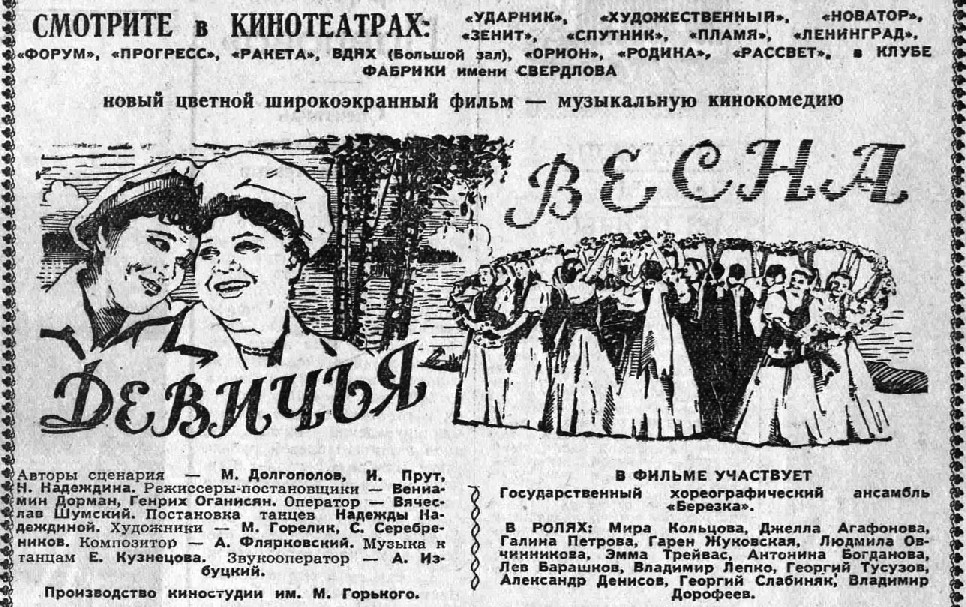
Screen: Russian Dancers:’Springtime on Volga’ Features Beryozka
By A.h. Weiler Dec. 25, 1961
THAT perceptive Russian—or Russians—who came up with the brilliant idea of filming the Beryozka Folk Ballet in action and in color is hereby awarded the Order of Gratitude, First Class. And the fumblers who thought it necessary to paint these dancing lilies by intruding on their artistry with as banal a romance as is erratically unreeled in “Springtime on the Volga,” which arrived at the Cameo Theatre on Saturday, are consigned to watch dull musical comedies forever.The fact is that the screen play fashioned by M. Dolgopolov and I. Prut is as jerry-built and artificial as the dancing is genuinely beautiful and original. In this case, the flimsy saga of a young, handsome Moscow optician who has been adoring from afar a demure and attractive blonde Beryozka ballerina, whom he follows, as a temporary cook, on a steamer tour of Volga towns made by her troupe, is hardly an inspired affair. Even with minor spats and misunderstandings, it is telegraphed from the outset that nice boy will get nice girl. Change the names and we have a badly and quickly contrived musical of the Nineteen Twenties.On the other hand, the all-girl Beryozka ensemble of more than forty performers, who were seen in person by fortunate theatregoers when they did a twelve-week coast-to-coast tour starting with a stand at the Broadway Theatre here in November, 1958, are as photogenic as the silver birch trees for which the group is named.There are about a half-dozen native dances, mostly of Ukraninian origin that set the screen aflame with color and action. The opening reel, where the dancers glide like mechanical dolls and end in a crescendo of whirling skirts is derivative of both folk and ballet terpsichore. And, equally exciting are a pantomimic “Four Seasons” number and a stately dance done with filmy scarves is true grace personified.The ladies not only are pretty as pictures but also appear to be having as much fun as they project to a viewer. M. Koltsava and G. Petrov as the girl and boy of this amateur romance are equally easy to look at, as are their supporting players, but they have little beyond that simple attribute with which to work.”It’s hard to believe that you’re a simple Russian girl,” our hapless hero says to the light of his life in a moment of frustration. Our boy obviously missed the point entirely. It is not the girl but the plot that is much too simple. And the Beryozka troupe is impossible to top.Rounding out the program is a twenty-minute documentary featuring the Russian tenor, titled, “Lemeshev Sings,” and a travelogue, “A Visit to Odessa.”
The Cast SPRINGTIME ON THE VOLGA; screen play by M. Dolgopolov and I. Prut; directed by V. Dorman and G. Oganosian; choreography by N. Nadezdina; produced by Gorky Film Studios and presented by Artkino.
At the Cameo Theatre, Eighth Avenue and Forty-fourth Street 23 December 1961 (New York City, New York). Running time: Seventy-five minutes.
Mira . . . . . M Koltsova
Galya . . . . . G. Petrov
Katya . . . . . D. Agafonova
Garen . . . . . G. Zhukovskaya
Liudmilla . . . . . L. Ovchinnikovaand
The Bervozka Dance Ensemble
A version of this article appears in print on Dec. 25, 1961 of the National edition with the headline: Screen: Russian Dancers:’Springtime on Volga’ Features Beryozka. Order Reprints | Today’s Paper | Subscribe
Широкоэкранный вариант начал демонстрироваться в СССР 14 мая 1960 года; в Финляндии (Finland) — 06.01.1961; в Венгрии (Hungary) — 16.03.1961; в США (USA) — 23.12.1961; в Мексике (Mexico) — 19.10.1962.
| ФИЛЬМОГРАФИЯ ОТЕЧЕСТВЕННЫХ ФИЛЬМОВ |



